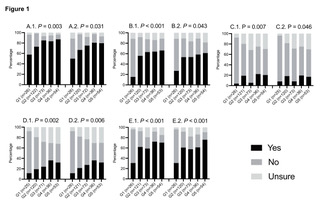Global survey on disparities in education on organ donation and transplantation
Andrea Herrera Gayol1, Medhat Askar2, Gabriel Gondolesi3, Vivek Kute4, Hari Shankar4, Carlos Diaz5, Karen Dwyer6, Nithya Krishnan7, Shaifali Sandal8, Marcelo Cantarovich8.
1AHG Consultant, Westmount, QC, Canada; 2Qatar University, Doha, Qatar; 3Surgery, Georgetown University , Washington, DC, United States; 4Medicine, Gujarat University, Ahmedabad, India; 5Medicine, CEMIC, Buenos AIres, Argentina; 6Medicine, Melbourne University, Melbourne , Australia; 7Medicine, Coventry University, Coventry, United Kingdom; 8Medicine, McGill University, Montreal, QC, Canada
TTS Access to Transplantation working group and the participating transplantation societies.
Introduction: The Global Observatory on Donation and Transplantation (GODT) reported that <10% of the transplantation (Tx) needs are met. Our goal was to evaluate education on organ donation and transplantation (ODT) globally.
Methods: We performed a global survey from May 2022 to March 2023, involving Tx physicians and surgeons. The answers were sorted as per the mean deceased donation (DD) rate per million population (PMP) from yrs 2016-2021 (2020 was excluded because of the COVID-19 pandemic): 1) No DD reported, or no data provided to GODT; 2) <10; 3) 10-19.9; 4) 20-29.9; 5) 30 DD PMP.
Results: We analyzed 438 answers. We found significant differences across countries according to the DD rate on education on ODT in the following: Fig.1.A.1. postgraduate medical education in your country (P=0.003) and 1.A.2. region (P=0.03); Fig.1.B.1. undergraduate medical school in your country (P<0.001) and 1.B.2. region (P=0.04); Fig.1.C.1. in elementary school in your country (P=0.007) and 1.C.2. region (P=0.04); Fig.1.D.1. in high school in your country (P=0.002) and Fig.1.D.2. region (P=0.006); and Fig.1.E.1. for the public in your country (P<0.001), and Fig.1.E.2. region (P<0.001). The differences were observed mainly in counties with lower DD rates.
Conclusion: This survey suggests that there are differences in education on ODT globally, ranging from elementary school to public and postgraduate medical studies. Increased needs were seen in countries with decreased DD rates. Educational activities that focus on national and regional needs should contribute to increasing knowledge about ODT and access to Tx worldwide.

[1] School education
[2] Post-grade education
[3] Public education
[4] Undergraduate education